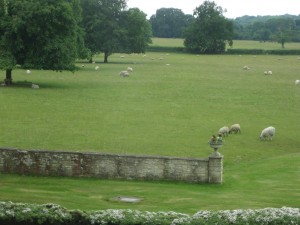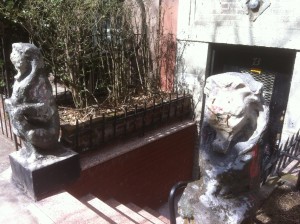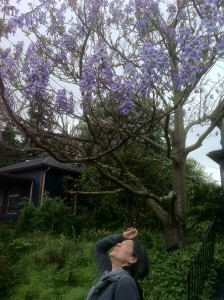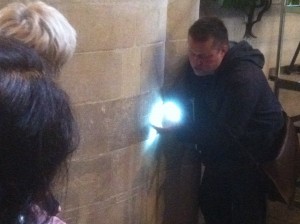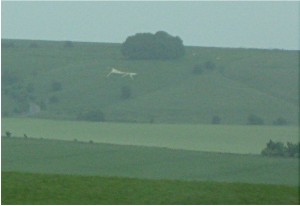It seems like forever since I’ve posted to this blog and so much has happened. A lot of ‘to-ing’ and ‘fro-ing’, most of it delightful, in addition to my usual hunkerings down in Whaletown and old Alphabet City. Everywhere there is strangeness and beauty and I am increasingly unsure what to make of it all, how to narrativize what I am seeing into some kind of coherent whole. So the phrase ‘wool-gathering’ has come to mind. I guess that is what I am doing. Yet there have been such fascinating moments:
These little faceless lions on St. Marks Place:
A message (anguished? ironic?) scrawled on an aluminum box in the subway:
Back on the West Coast, the Paulownias bloomed in record numbers, purply blue and headily fragrant yet somehow sad against the tattered span of spring sky.
Ruth’s book ‘A Tale for the Time Being’ unfurled its pages into the world like some great nectariferous flower and for that and other reasons there has been a flurry of occasions for me to travel and meet delightful and interesting people. For the second time in the past few months I found myself in the storied environs of old Blighty, with its history oozing from every crack and crevice. In Norwich’s ancient cathedral, a man named Colin from the Norfolk Mediaeval Graffiti Society showed us a rich palimpsest of mason’s sketches, people’s names inverted into curses, pornography and devotional iconography scratched over the centuries into the cold stone of its walls. Almost invisible under ambient light, this filigree of subtexts comes alive when illuminated sideways using an iPhone’s flashlight app; the story of the nation furtively inscribed by those left waiting in the shadows of its history.
I’m gazing through the window of a train car chugging through the viridian English countryside. Tidy villages, picturesque hedgerows, church spires and mustard fields drift by and I realize I have seen all this before, long before ever having set foot on this historically freighted little island, somewhere deep in my mind’s eye where there exists an inner England, an ingrained point of aesthetic reference I’d long ago absorbed from having grown up in one of its former colonies, where ‘English-ness’ was a pervasive value uneasily superimposed onto the vastness and anomie of the great New World.
When I was a child, Canada was still referred to as a ‘dominion’ and at the start of each school day, ‘God Save the Queen’ came wheezing across the tinny public address system and we were obliged to sing along, while Elizabeth’s diamond tiaraed, porcelain-skinned portrait beamed beatifically down at us from it perch at the front of the room. Toronto’s older streets and buildings have a defiantly English quality about them, as do many of the place names, even some of the social mores; the curious ‘Sorry! Sorry!’ style of passive aggressive apologizing, that I still find hard to understand. Though I was a non Anglo-Saxon child of working class immigrants, somewhere between ‘Rupert the Bear’ and ‘Wuthering Heights’ a sensibility must have seeped in and now the real English landscape seems to me archetypical and somehow soothing, verdant and bucolic yet a bit chaste in the way that nature is so obviously confined within the dominion of man.
This aesthetic of control helped spur colonialism and the British Empire which was not without its brutalities. It caused landscapes all over the globe to be transformed into ‘neo-Englands, regardless of climate or the aspirations of the indigenous people. Yet the English landscape is itself a palimpsest of outside influences: much of its now open country was initially deforested by incoming Neolithic pastoralists, its stately chestnut and walnut trees a legacy of invading Roman Legions and its imposing ‘motte-and-bailey’ style earthworks on which so many of the country’siconic castles are built, introduced by the Norman conquerors
A compulsion to amass and showcase objects to reflect the breadth and splendor of the realm is characteristic of many an empire and in England this impulse has been particularly strong. Its museums and galleries know few equals and contain some of the world’s most exquisite treasures. I’ll expand on this later but I just had to draw your attention to Tippoo’s Tiger.
Bringing to mind some of the themes in Taussig’s ‘Mimesis and Alterity,’ sometimes an appropriated object is itself fashioned in the image of appropriator. This is the case of Tippoo’s Tiger, on display at the Victoria and Albert; a curious, almost life-size automaton of a big cat plunging its fangs deftly into the neck of a prone British Soldier. A curious hybrid of Indian and European technology, the tiger contains clockwork mechanisms that make the soldier wail and thrash his hand around while the tiger grunts with gustatory satisfaction. Here is a link to a video of this amazing contraption at work:
The object’s original owner, Tippu the Sultan of Mysore, was clearly no fan of the English and it eventually made its way to England as plunder of war in 1799, after his death in the battle of Siringapatam. Tippu might have the last laugh however; his whimsical, anti-colonialist tiger still raises eyebrows, right in the heart of the now vanished empire, over two hundred years after his death.
Though two hundred years seems to me a very long time, in a country where Neolithic tumuli and Mediaeval cathedrals coexist with Tesco parking lots and ‘The Shard,’ one’s experience of history, that is to say the kind of history measured in the accumulation of visible human artifacts, has a much different feel to it from North America, where the built and unbuilt environments have a rawer, less resolved relationship with each other and there is a tentativeness to the human imprint as if everything, even big cities, might revert to wasteland or wilderness if we just looked the other way. On our side of the pond, some of the most iconic cities such as Detroit are already devolving into atavistic, less populated versions of themselves, barely two centuries after their incorporation, with once prosperous neighbourhoods and industrial parks reverting into landscapes of ruin and weed fields – prime habitat for pheasants!
At least here nature is regaining a foothold.
Yet more affluent areas of North America continue to metastasize toward that most banal of common denominators – the vast, unplanned sprawl of the edge city; a privatized, drive-thru landscape, deliberately generic and purged of history, devoid of landmarks and deficient in public spaces.
England, despite its tumultuous history, has looked like England for a very long time. According to W.G. Hoskins in his ‘The Making of the English Landscapes’:
‘outside the industrial areas most of the settlements in existence today were founded between the fifth and eleventh centuries and mentioned in the Domesday Book.’
Given the density of the population it is astonishing to see how much of the English countryside remains intact. While most of the forests and fields I knew as a child growing up on the rural fringes of Toronto have been subsumed by the worst kind of strip mall and tract home hideousness, the English have managed to legislate anti-sprawl policies and enshrine footpath laws to guarantee public right-of-way through vast tracts of their landscape. The contrast with our private property-obsessed culture in North America couldn’t be greater.



